Evidence-Based Argument: Drug Checking at Music Festivals
VerifiedAdded on 2022/08/20
|11
|3288
|14
Essay
AI Summary
This essay provides an evidence-based argument for policy changes regarding drug use at music festivals. It begins by defining substance use and highlighting the increasing prevalence of drug culture at music festivals, particularly those featuring electronic dance music. The essay then explores the social harms associated with drug use, including health risks like heatstroke and dehydration, as well as the impact on attendees' social functioning and the broader community. It cites data on drug consumption rates at music festivals and details the negative consequences, including hospitalizations and fatalities. The core of the essay proposes a policy change that allows for drug checking and pill testing at music festivals. This includes establishing medical tents, requiring disclaimers and substance samples for testing, and providing counseling based on the results. The essay explains the testing process, the use of infrared spectroscopy, and the potential for harm reduction. It references the success of pill testing trials and emphasizes the benefits of this policy in preventing the sale of hazardous drugs, altering user behavior, and providing opportunities for support and information. The essay concludes by reiterating the importance of drug checking in mitigating the social harms associated with substance use at music festivals and promoting public health.
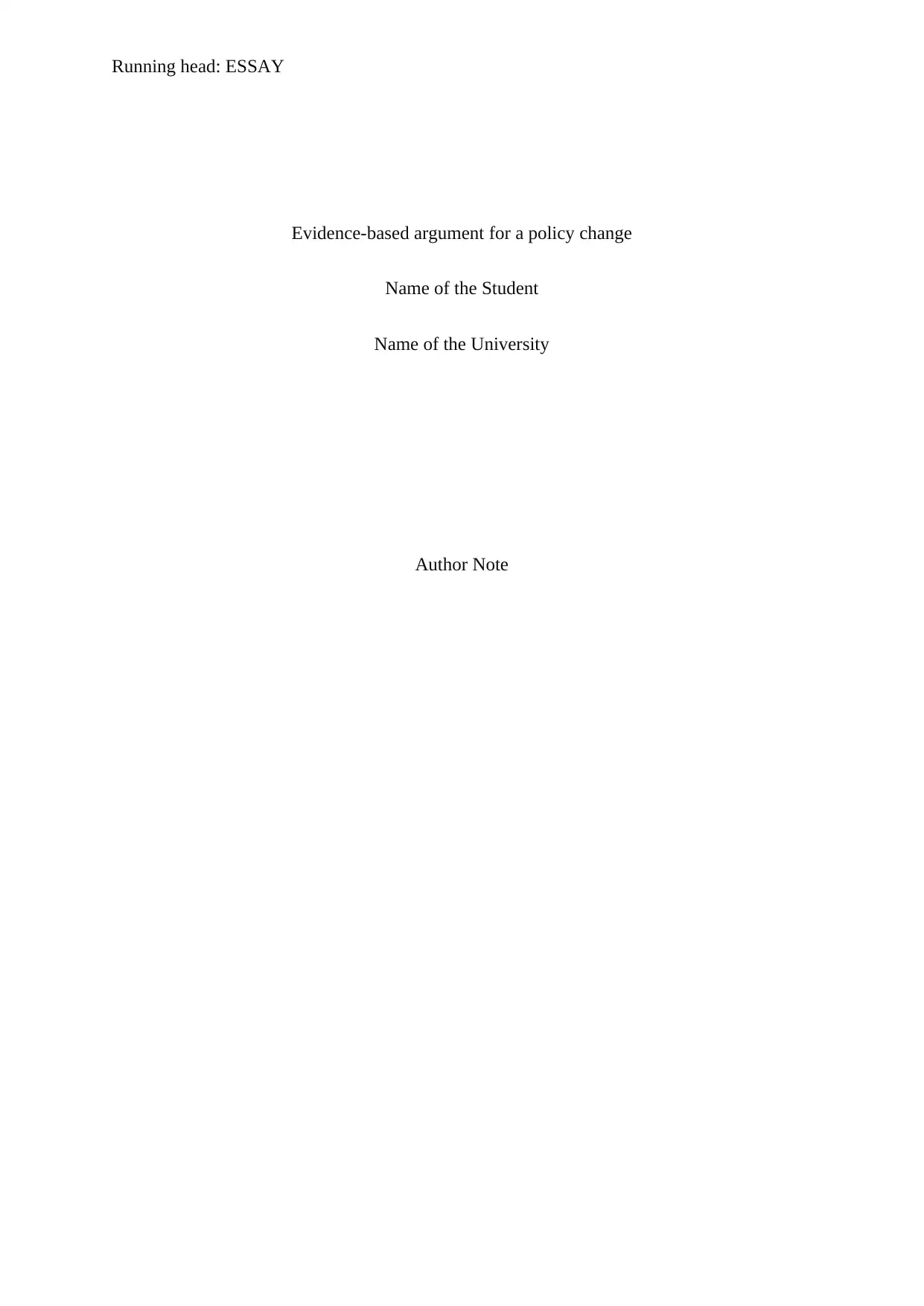
Running head: ESSAY
Evidence-based argument for a policy change
Name of the Student
Name of the University
Author Note
Evidence-based argument for a policy change
Name of the Student
Name of the University
Author Note
Paraphrase This Document
Need a fresh take? Get an instant paraphrase of this document with our AI Paraphraser
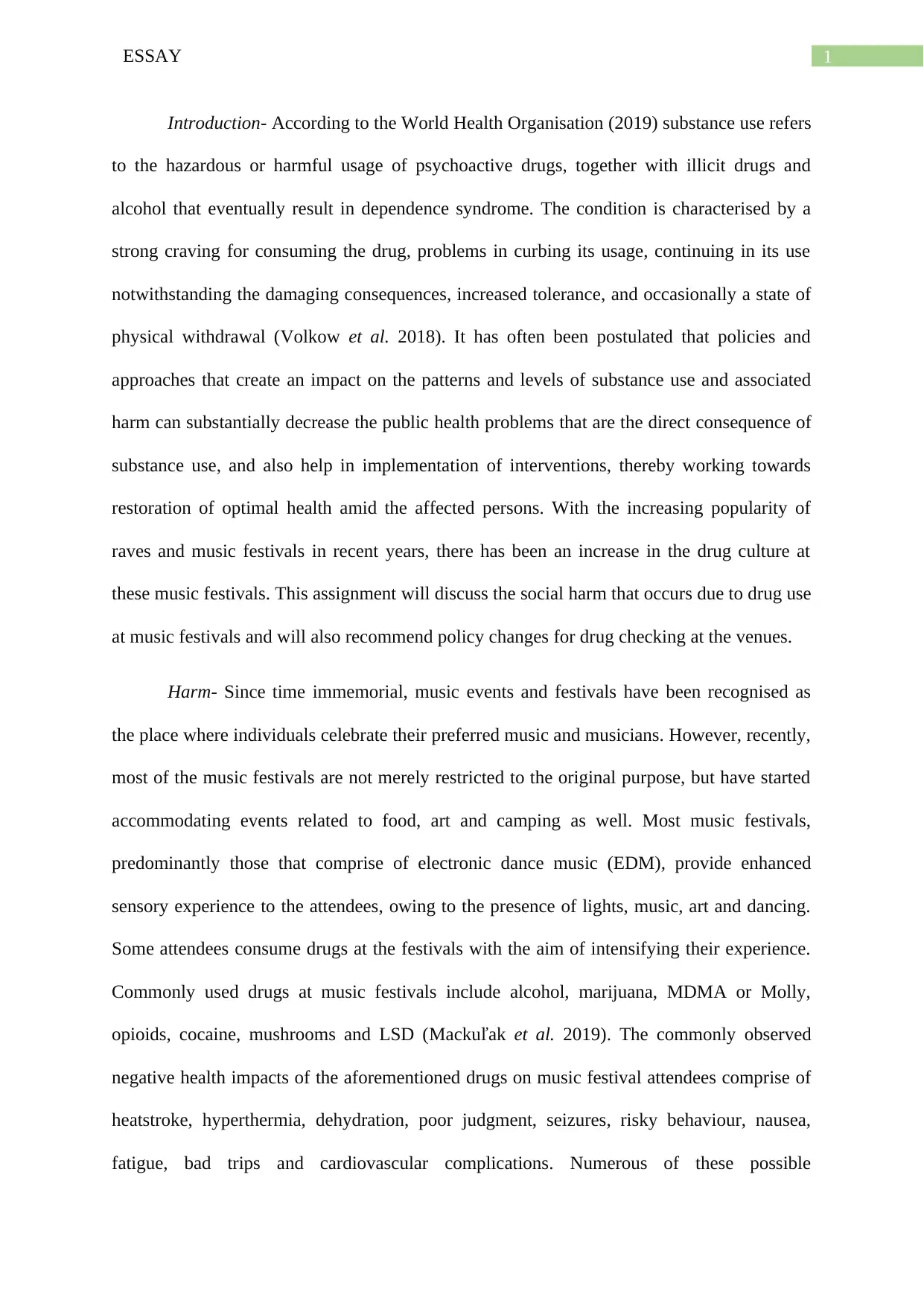
1ESSAY
Introduction- According to the World Health Organisation (2019) substance use refers
to the hazardous or harmful usage of psychoactive drugs, together with illicit drugs and
alcohol that eventually result in dependence syndrome. The condition is characterised by a
strong craving for consuming the drug, problems in curbing its usage, continuing in its use
notwithstanding the damaging consequences, increased tolerance, and occasionally a state of
physical withdrawal (Volkow et al. 2018). It has often been postulated that policies and
approaches that create an impact on the patterns and levels of substance use and associated
harm can substantially decrease the public health problems that are the direct consequence of
substance use, and also help in implementation of interventions, thereby working towards
restoration of optimal health amid the affected persons. With the increasing popularity of
raves and music festivals in recent years, there has been an increase in the drug culture at
these music festivals. This assignment will discuss the social harm that occurs due to drug use
at music festivals and will also recommend policy changes for drug checking at the venues.
Harm- Since time immemorial, music events and festivals have been recognised as
the place where individuals celebrate their preferred music and musicians. However, recently,
most of the music festivals are not merely restricted to the original purpose, but have started
accommodating events related to food, art and camping as well. Most music festivals,
predominantly those that comprise of electronic dance music (EDM), provide enhanced
sensory experience to the attendees, owing to the presence of lights, music, art and dancing.
Some attendees consume drugs at the festivals with the aim of intensifying their experience.
Commonly used drugs at music festivals include alcohol, marijuana, MDMA or Molly,
opioids, cocaine, mushrooms and LSD (Mackuľak et al. 2019). The commonly observed
negative health impacts of the aforementioned drugs on music festival attendees comprise of
heatstroke, hyperthermia, dehydration, poor judgment, seizures, risky behaviour, nausea,
fatigue, bad trips and cardiovascular complications. Numerous of these possible
Introduction- According to the World Health Organisation (2019) substance use refers
to the hazardous or harmful usage of psychoactive drugs, together with illicit drugs and
alcohol that eventually result in dependence syndrome. The condition is characterised by a
strong craving for consuming the drug, problems in curbing its usage, continuing in its use
notwithstanding the damaging consequences, increased tolerance, and occasionally a state of
physical withdrawal (Volkow et al. 2018). It has often been postulated that policies and
approaches that create an impact on the patterns and levels of substance use and associated
harm can substantially decrease the public health problems that are the direct consequence of
substance use, and also help in implementation of interventions, thereby working towards
restoration of optimal health amid the affected persons. With the increasing popularity of
raves and music festivals in recent years, there has been an increase in the drug culture at
these music festivals. This assignment will discuss the social harm that occurs due to drug use
at music festivals and will also recommend policy changes for drug checking at the venues.
Harm- Since time immemorial, music events and festivals have been recognised as
the place where individuals celebrate their preferred music and musicians. However, recently,
most of the music festivals are not merely restricted to the original purpose, but have started
accommodating events related to food, art and camping as well. Most music festivals,
predominantly those that comprise of electronic dance music (EDM), provide enhanced
sensory experience to the attendees, owing to the presence of lights, music, art and dancing.
Some attendees consume drugs at the festivals with the aim of intensifying their experience.
Commonly used drugs at music festivals include alcohol, marijuana, MDMA or Molly,
opioids, cocaine, mushrooms and LSD (Mackuľak et al. 2019). The commonly observed
negative health impacts of the aforementioned drugs on music festival attendees comprise of
heatstroke, hyperthermia, dehydration, poor judgment, seizures, risky behaviour, nausea,
fatigue, bad trips and cardiovascular complications. Numerous of these possible
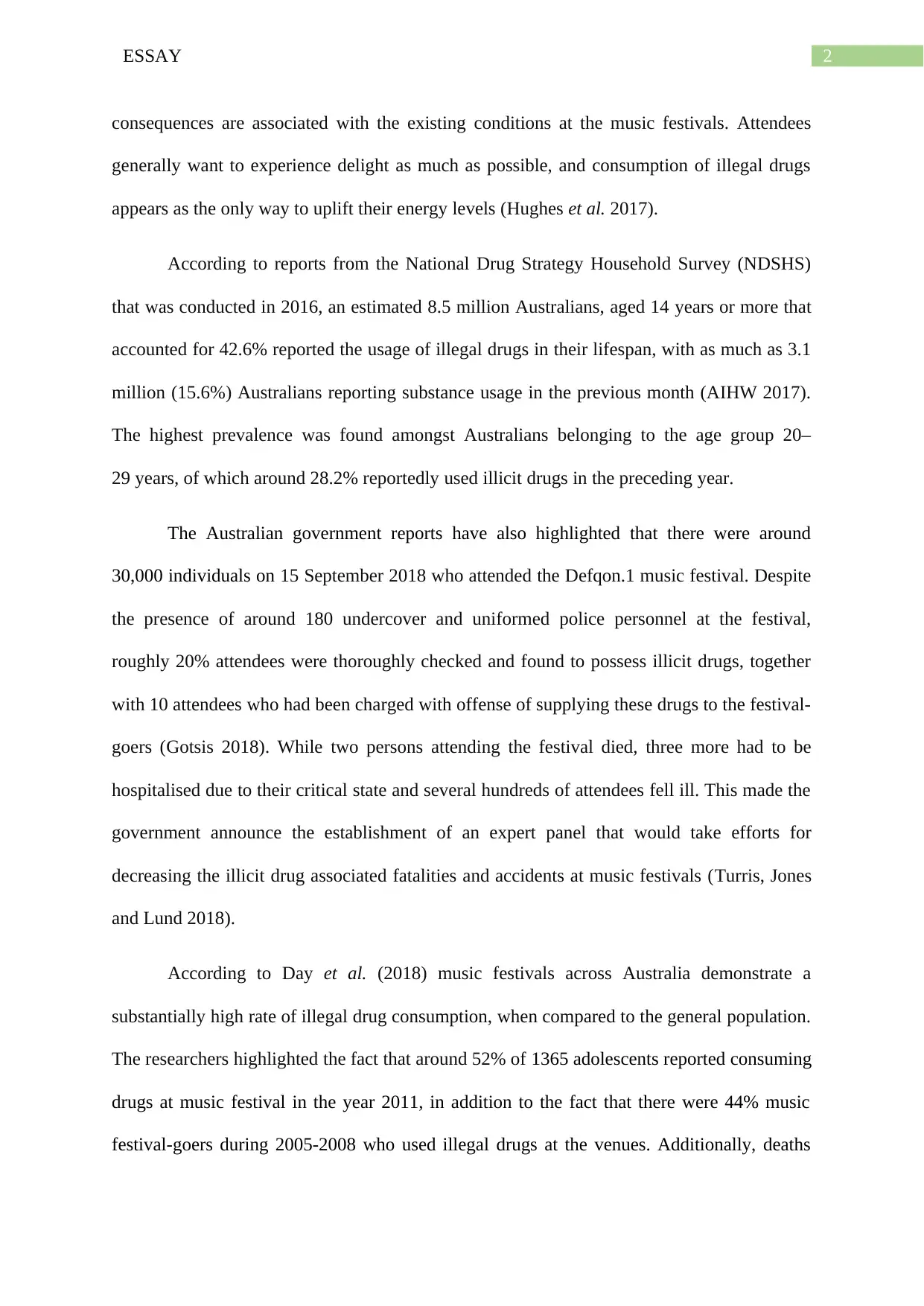
2ESSAY
consequences are associated with the existing conditions at the music festivals. Attendees
generally want to experience delight as much as possible, and consumption of illegal drugs
appears as the only way to uplift their energy levels (Hughes et al. 2017).
According to reports from the National Drug Strategy Household Survey (NDSHS)
that was conducted in 2016, an estimated 8.5 million Australians, aged 14 years or more that
accounted for 42.6% reported the usage of illegal drugs in their lifespan, with as much as 3.1
million (15.6%) Australians reporting substance usage in the previous month (AIHW 2017).
The highest prevalence was found amongst Australians belonging to the age group 20–
29 years, of which around 28.2% reportedly used illicit drugs in the preceding year.
The Australian government reports have also highlighted that there were around
30,000 individuals on 15 September 2018 who attended the Defqon.1 music festival. Despite
the presence of around 180 undercover and uniformed police personnel at the festival,
roughly 20% attendees were thoroughly checked and found to possess illicit drugs, together
with 10 attendees who had been charged with offense of supplying these drugs to the festival-
goers (Gotsis 2018). While two persons attending the festival died, three more had to be
hospitalised due to their critical state and several hundreds of attendees fell ill. This made the
government announce the establishment of an expert panel that would take efforts for
decreasing the illicit drug associated fatalities and accidents at music festivals (Turris, Jones
and Lund 2018).
According to Day et al. (2018) music festivals across Australia demonstrate a
substantially high rate of illegal drug consumption, when compared to the general population.
The researchers highlighted the fact that around 52% of 1365 adolescents reported consuming
drugs at music festival in the year 2011, in addition to the fact that there were 44% music
festival-goers during 2005-2008 who used illegal drugs at the venues. Additionally, deaths
consequences are associated with the existing conditions at the music festivals. Attendees
generally want to experience delight as much as possible, and consumption of illegal drugs
appears as the only way to uplift their energy levels (Hughes et al. 2017).
According to reports from the National Drug Strategy Household Survey (NDSHS)
that was conducted in 2016, an estimated 8.5 million Australians, aged 14 years or more that
accounted for 42.6% reported the usage of illegal drugs in their lifespan, with as much as 3.1
million (15.6%) Australians reporting substance usage in the previous month (AIHW 2017).
The highest prevalence was found amongst Australians belonging to the age group 20–
29 years, of which around 28.2% reportedly used illicit drugs in the preceding year.
The Australian government reports have also highlighted that there were around
30,000 individuals on 15 September 2018 who attended the Defqon.1 music festival. Despite
the presence of around 180 undercover and uniformed police personnel at the festival,
roughly 20% attendees were thoroughly checked and found to possess illicit drugs, together
with 10 attendees who had been charged with offense of supplying these drugs to the festival-
goers (Gotsis 2018). While two persons attending the festival died, three more had to be
hospitalised due to their critical state and several hundreds of attendees fell ill. This made the
government announce the establishment of an expert panel that would take efforts for
decreasing the illicit drug associated fatalities and accidents at music festivals (Turris, Jones
and Lund 2018).
According to Day et al. (2018) music festivals across Australia demonstrate a
substantially high rate of illegal drug consumption, when compared to the general population.
The researchers highlighted the fact that around 52% of 1365 adolescents reported consuming
drugs at music festival in the year 2011, in addition to the fact that there were 44% music
festival-goers during 2005-2008 who used illegal drugs at the venues. Additionally, deaths
⊘ This is a preview!⊘
Do you want full access?
Subscribe today to unlock all pages.

Trusted by 1+ million students worldwide
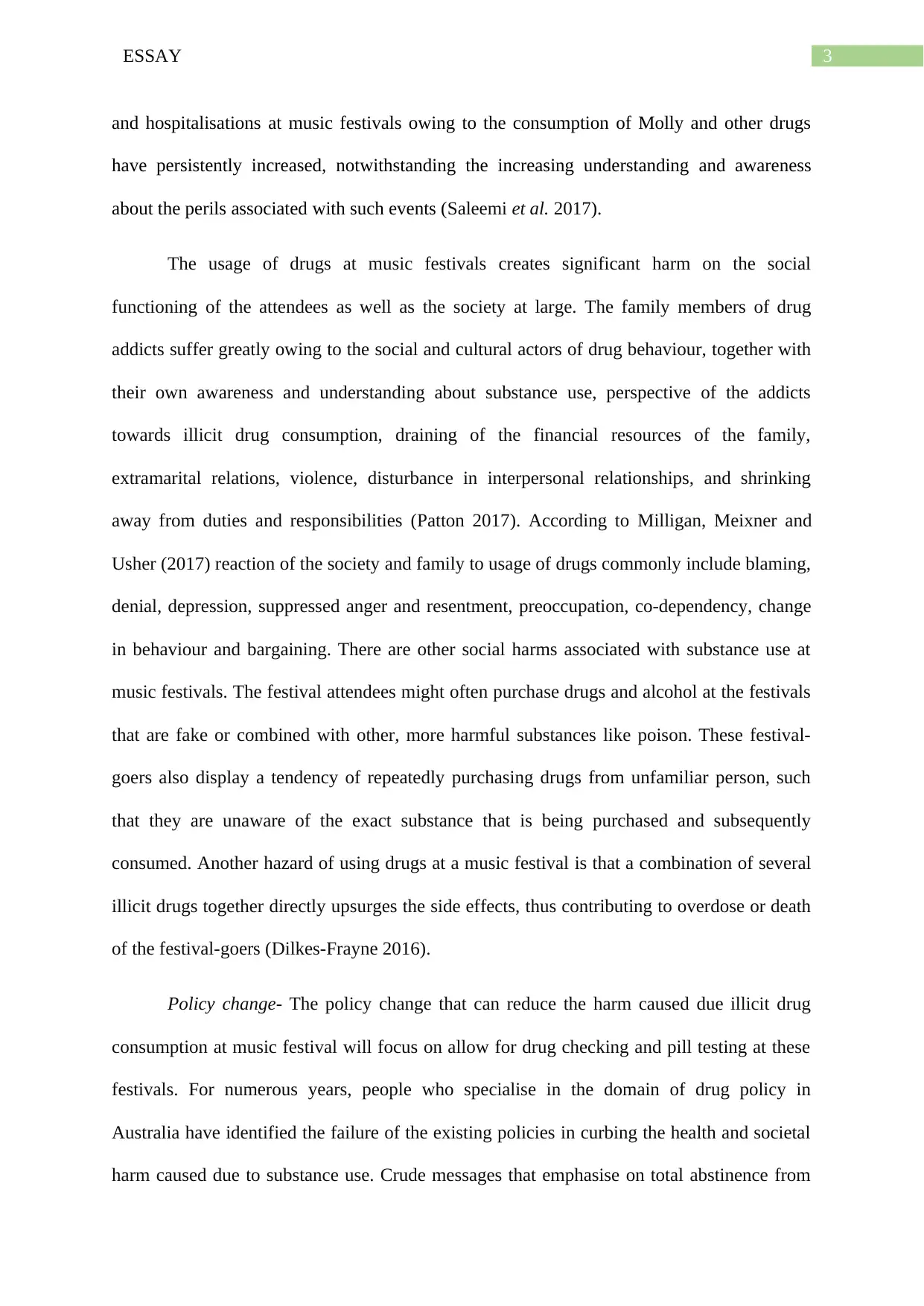
3ESSAY
and hospitalisations at music festivals owing to the consumption of Molly and other drugs
have persistently increased, notwithstanding the increasing understanding and awareness
about the perils associated with such events (Saleemi et al. 2017).
The usage of drugs at music festivals creates significant harm on the social
functioning of the attendees as well as the society at large. The family members of drug
addicts suffer greatly owing to the social and cultural actors of drug behaviour, together with
their own awareness and understanding about substance use, perspective of the addicts
towards illicit drug consumption, draining of the financial resources of the family,
extramarital relations, violence, disturbance in interpersonal relationships, and shrinking
away from duties and responsibilities (Patton 2017). According to Milligan, Meixner and
Usher (2017) reaction of the society and family to usage of drugs commonly include blaming,
denial, depression, suppressed anger and resentment, preoccupation, co-dependency, change
in behaviour and bargaining. There are other social harms associated with substance use at
music festivals. The festival attendees might often purchase drugs and alcohol at the festivals
that are fake or combined with other, more harmful substances like poison. These festival-
goers also display a tendency of repeatedly purchasing drugs from unfamiliar person, such
that they are unaware of the exact substance that is being purchased and subsequently
consumed. Another hazard of using drugs at a music festival is that a combination of several
illicit drugs together directly upsurges the side effects, thus contributing to overdose or death
of the festival-goers (Dilkes-Frayne 2016).
Policy change- The policy change that can reduce the harm caused due illicit drug
consumption at music festival will focus on allow for drug checking and pill testing at these
festivals. For numerous years, people who specialise in the domain of drug policy in
Australia have identified the failure of the existing policies in curbing the health and societal
harm caused due to substance use. Crude messages that emphasise on total abstinence from
and hospitalisations at music festivals owing to the consumption of Molly and other drugs
have persistently increased, notwithstanding the increasing understanding and awareness
about the perils associated with such events (Saleemi et al. 2017).
The usage of drugs at music festivals creates significant harm on the social
functioning of the attendees as well as the society at large. The family members of drug
addicts suffer greatly owing to the social and cultural actors of drug behaviour, together with
their own awareness and understanding about substance use, perspective of the addicts
towards illicit drug consumption, draining of the financial resources of the family,
extramarital relations, violence, disturbance in interpersonal relationships, and shrinking
away from duties and responsibilities (Patton 2017). According to Milligan, Meixner and
Usher (2017) reaction of the society and family to usage of drugs commonly include blaming,
denial, depression, suppressed anger and resentment, preoccupation, co-dependency, change
in behaviour and bargaining. There are other social harms associated with substance use at
music festivals. The festival attendees might often purchase drugs and alcohol at the festivals
that are fake or combined with other, more harmful substances like poison. These festival-
goers also display a tendency of repeatedly purchasing drugs from unfamiliar person, such
that they are unaware of the exact substance that is being purchased and subsequently
consumed. Another hazard of using drugs at a music festival is that a combination of several
illicit drugs together directly upsurges the side effects, thus contributing to overdose or death
of the festival-goers (Dilkes-Frayne 2016).
Policy change- The policy change that can reduce the harm caused due illicit drug
consumption at music festival will focus on allow for drug checking and pill testing at these
festivals. For numerous years, people who specialise in the domain of drug policy in
Australia have identified the failure of the existing policies in curbing the health and societal
harm caused due to substance use. Crude messages that emphasise on total abstinence from
Paraphrase This Document
Need a fresh take? Get an instant paraphrase of this document with our AI Paraphraser
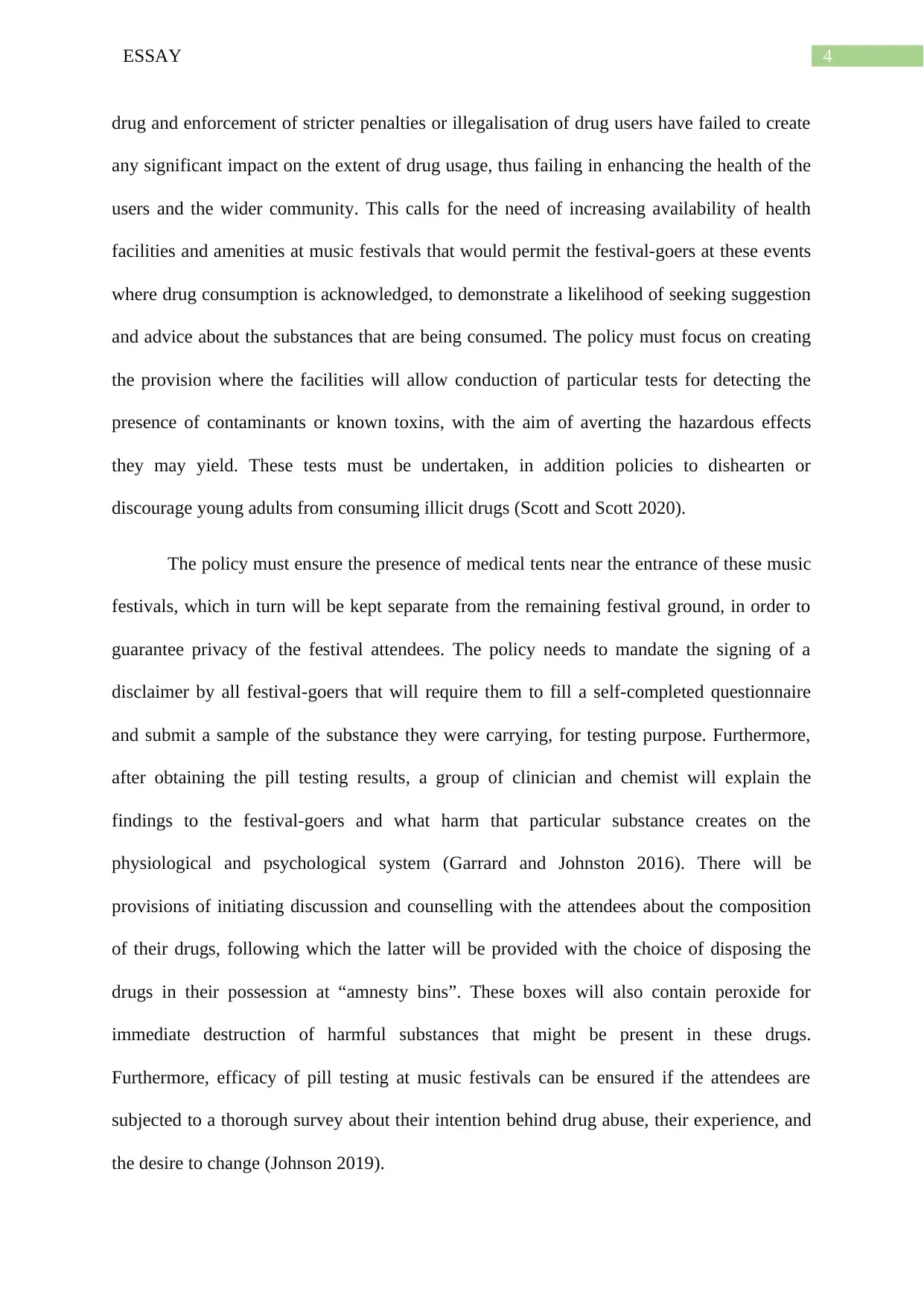
4ESSAY
drug and enforcement of stricter penalties or illegalisation of drug users have failed to create
any significant impact on the extent of drug usage, thus failing in enhancing the health of the
users and the wider community. This calls for the need of increasing availability of health
facilities and amenities at music festivals that would permit the festival-goers at these events
where drug consumption is acknowledged, to demonstrate a likelihood of seeking suggestion
and advice about the substances that are being consumed. The policy must focus on creating
the provision where the facilities will allow conduction of particular tests for detecting the
presence of contaminants or known toxins, with the aim of averting the hazardous effects
they may yield. These tests must be undertaken, in addition policies to dishearten or
discourage young adults from consuming illicit drugs (Scott and Scott 2020).
The policy must ensure the presence of medical tents near the entrance of these music
festivals, which in turn will be kept separate from the remaining festival ground, in order to
guarantee privacy of the festival attendees. The policy needs to mandate the signing of a
disclaimer by all festival-goers that will require them to fill a self-completed questionnaire
and submit a sample of the substance they were carrying, for testing purpose. Furthermore,
after obtaining the pill testing results, a group of clinician and chemist will explain the
findings to the festival-goers and what harm that particular substance creates on the
physiological and psychological system (Garrard and Johnston 2016). There will be
provisions of initiating discussion and counselling with the attendees about the composition
of their drugs, following which the latter will be provided with the choice of disposing the
drugs in their possession at “amnesty bins”. These boxes will also contain peroxide for
immediate destruction of harmful substances that might be present in these drugs.
Furthermore, efficacy of pill testing at music festivals can be ensured if the attendees are
subjected to a thorough survey about their intention behind drug abuse, their experience, and
the desire to change (Johnson 2019).
drug and enforcement of stricter penalties or illegalisation of drug users have failed to create
any significant impact on the extent of drug usage, thus failing in enhancing the health of the
users and the wider community. This calls for the need of increasing availability of health
facilities and amenities at music festivals that would permit the festival-goers at these events
where drug consumption is acknowledged, to demonstrate a likelihood of seeking suggestion
and advice about the substances that are being consumed. The policy must focus on creating
the provision where the facilities will allow conduction of particular tests for detecting the
presence of contaminants or known toxins, with the aim of averting the hazardous effects
they may yield. These tests must be undertaken, in addition policies to dishearten or
discourage young adults from consuming illicit drugs (Scott and Scott 2020).
The policy must ensure the presence of medical tents near the entrance of these music
festivals, which in turn will be kept separate from the remaining festival ground, in order to
guarantee privacy of the festival attendees. The policy needs to mandate the signing of a
disclaimer by all festival-goers that will require them to fill a self-completed questionnaire
and submit a sample of the substance they were carrying, for testing purpose. Furthermore,
after obtaining the pill testing results, a group of clinician and chemist will explain the
findings to the festival-goers and what harm that particular substance creates on the
physiological and psychological system (Garrard and Johnston 2016). There will be
provisions of initiating discussion and counselling with the attendees about the composition
of their drugs, following which the latter will be provided with the choice of disposing the
drugs in their possession at “amnesty bins”. These boxes will also contain peroxide for
immediate destruction of harmful substances that might be present in these drugs.
Furthermore, efficacy of pill testing at music festivals can be ensured if the attendees are
subjected to a thorough survey about their intention behind drug abuse, their experience, and
the desire to change (Johnson 2019).
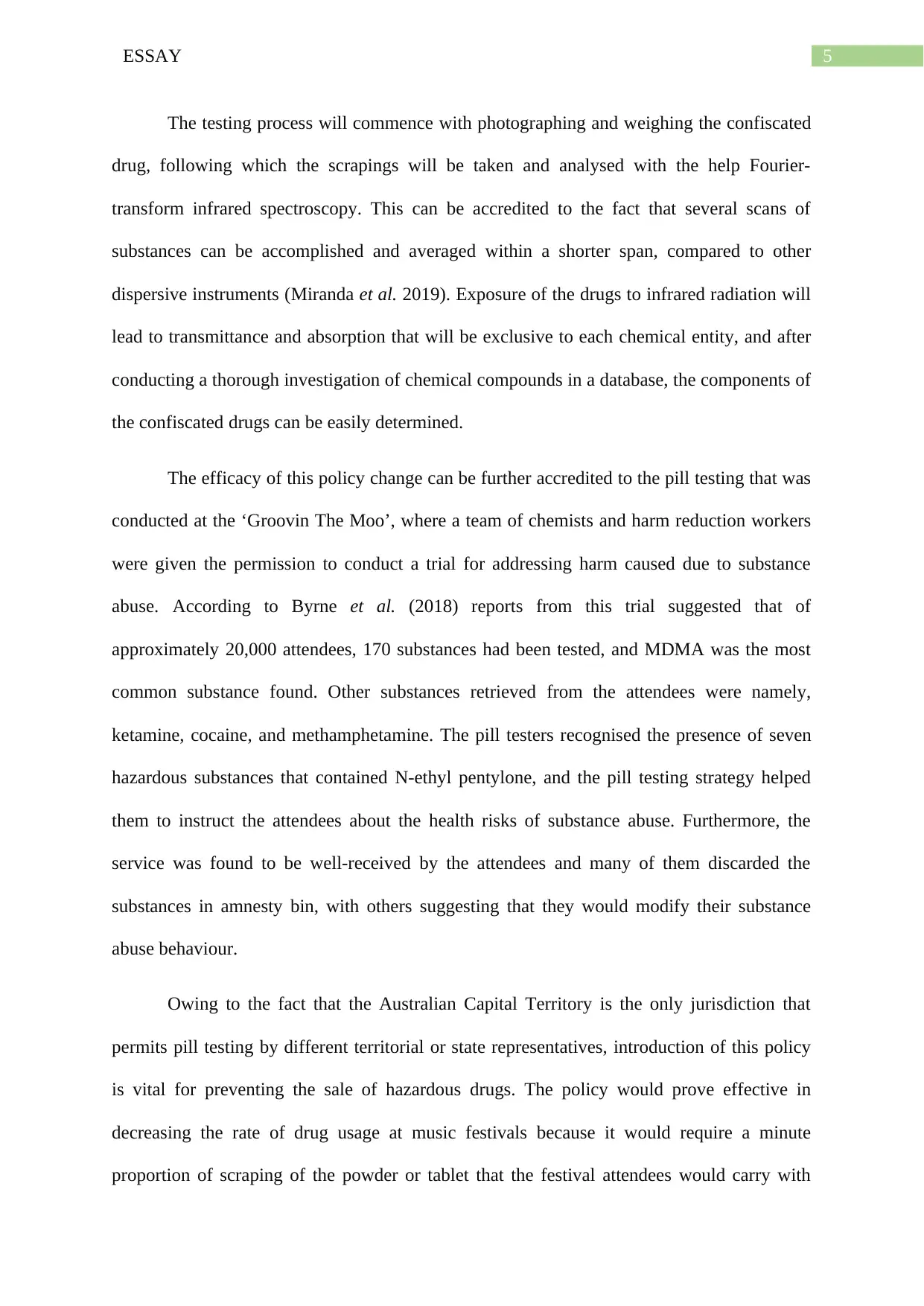
5ESSAY
The testing process will commence with photographing and weighing the confiscated
drug, following which the scrapings will be taken and analysed with the help Fourier-
transform infrared spectroscopy. This can be accredited to the fact that several scans of
substances can be accomplished and averaged within a shorter span, compared to other
dispersive instruments (Miranda et al. 2019). Exposure of the drugs to infrared radiation will
lead to transmittance and absorption that will be exclusive to each chemical entity, and after
conducting a thorough investigation of chemical compounds in a database, the components of
the confiscated drugs can be easily determined.
The efficacy of this policy change can be further accredited to the pill testing that was
conducted at the ‘Groovin The Moo’, where a team of chemists and harm reduction workers
were given the permission to conduct a trial for addressing harm caused due to substance
abuse. According to Byrne et al. (2018) reports from this trial suggested that of
approximately 20,000 attendees, 170 substances had been tested, and MDMA was the most
common substance found. Other substances retrieved from the attendees were namely,
ketamine, cocaine, and methamphetamine. The pill testers recognised the presence of seven
hazardous substances that contained N-ethyl pentylone, and the pill testing strategy helped
them to instruct the attendees about the health risks of substance abuse. Furthermore, the
service was found to be well-received by the attendees and many of them discarded the
substances in amnesty bin, with others suggesting that they would modify their substance
abuse behaviour.
Owing to the fact that the Australian Capital Territory is the only jurisdiction that
permits pill testing by different territorial or state representatives, introduction of this policy
is vital for preventing the sale of hazardous drugs. The policy would prove effective in
decreasing the rate of drug usage at music festivals because it would require a minute
proportion of scraping of the powder or tablet that the festival attendees would carry with
The testing process will commence with photographing and weighing the confiscated
drug, following which the scrapings will be taken and analysed with the help Fourier-
transform infrared spectroscopy. This can be accredited to the fact that several scans of
substances can be accomplished and averaged within a shorter span, compared to other
dispersive instruments (Miranda et al. 2019). Exposure of the drugs to infrared radiation will
lead to transmittance and absorption that will be exclusive to each chemical entity, and after
conducting a thorough investigation of chemical compounds in a database, the components of
the confiscated drugs can be easily determined.
The efficacy of this policy change can be further accredited to the pill testing that was
conducted at the ‘Groovin The Moo’, where a team of chemists and harm reduction workers
were given the permission to conduct a trial for addressing harm caused due to substance
abuse. According to Byrne et al. (2018) reports from this trial suggested that of
approximately 20,000 attendees, 170 substances had been tested, and MDMA was the most
common substance found. Other substances retrieved from the attendees were namely,
ketamine, cocaine, and methamphetamine. The pill testers recognised the presence of seven
hazardous substances that contained N-ethyl pentylone, and the pill testing strategy helped
them to instruct the attendees about the health risks of substance abuse. Furthermore, the
service was found to be well-received by the attendees and many of them discarded the
substances in amnesty bin, with others suggesting that they would modify their substance
abuse behaviour.
Owing to the fact that the Australian Capital Territory is the only jurisdiction that
permits pill testing by different territorial or state representatives, introduction of this policy
is vital for preventing the sale of hazardous drugs. The policy would prove effective in
decreasing the rate of drug usage at music festivals because it would require a minute
proportion of scraping of the powder or tablet that the festival attendees would carry with
⊘ This is a preview!⊘
Do you want full access?
Subscribe today to unlock all pages.

Trusted by 1+ million students worldwide
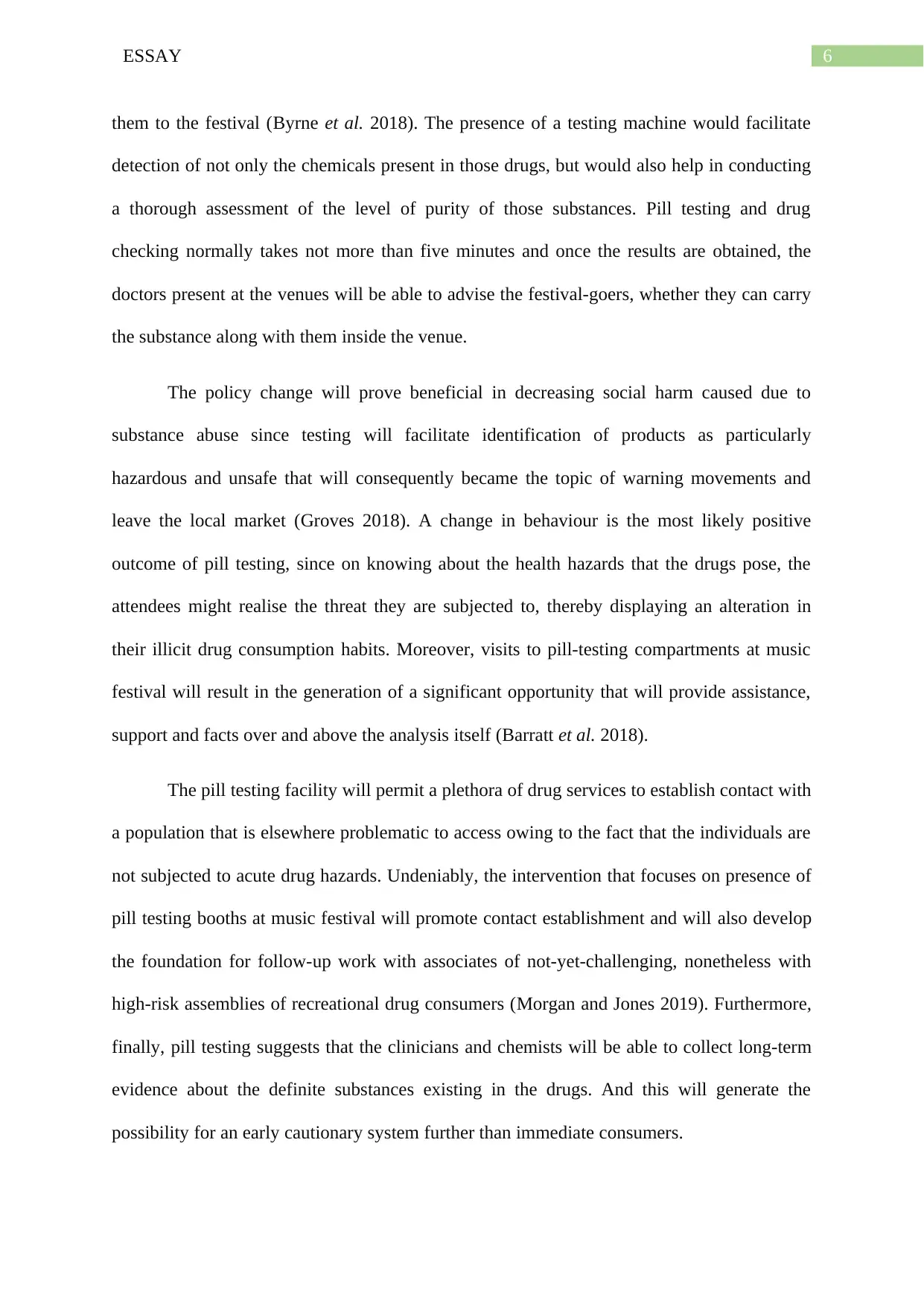
6ESSAY
them to the festival (Byrne et al. 2018). The presence of a testing machine would facilitate
detection of not only the chemicals present in those drugs, but would also help in conducting
a thorough assessment of the level of purity of those substances. Pill testing and drug
checking normally takes not more than five minutes and once the results are obtained, the
doctors present at the venues will be able to advise the festival-goers, whether they can carry
the substance along with them inside the venue.
The policy change will prove beneficial in decreasing social harm caused due to
substance abuse since testing will facilitate identification of products as particularly
hazardous and unsafe that will consequently became the topic of warning movements and
leave the local market (Groves 2018). A change in behaviour is the most likely positive
outcome of pill testing, since on knowing about the health hazards that the drugs pose, the
attendees might realise the threat they are subjected to, thereby displaying an alteration in
their illicit drug consumption habits. Moreover, visits to pill-testing compartments at music
festival will result in the generation of a significant opportunity that will provide assistance,
support and facts over and above the analysis itself (Barratt et al. 2018).
The pill testing facility will permit a plethora of drug services to establish contact with
a population that is elsewhere problematic to access owing to the fact that the individuals are
not subjected to acute drug hazards. Undeniably, the intervention that focuses on presence of
pill testing booths at music festival will promote contact establishment and will also develop
the foundation for follow-up work with associates of not-yet-challenging, nonetheless with
high-risk assemblies of recreational drug consumers (Morgan and Jones 2019). Furthermore,
finally, pill testing suggests that the clinicians and chemists will be able to collect long-term
evidence about the definite substances existing in the drugs. And this will generate the
possibility for an early cautionary system further than immediate consumers.
them to the festival (Byrne et al. 2018). The presence of a testing machine would facilitate
detection of not only the chemicals present in those drugs, but would also help in conducting
a thorough assessment of the level of purity of those substances. Pill testing and drug
checking normally takes not more than five minutes and once the results are obtained, the
doctors present at the venues will be able to advise the festival-goers, whether they can carry
the substance along with them inside the venue.
The policy change will prove beneficial in decreasing social harm caused due to
substance abuse since testing will facilitate identification of products as particularly
hazardous and unsafe that will consequently became the topic of warning movements and
leave the local market (Groves 2018). A change in behaviour is the most likely positive
outcome of pill testing, since on knowing about the health hazards that the drugs pose, the
attendees might realise the threat they are subjected to, thereby displaying an alteration in
their illicit drug consumption habits. Moreover, visits to pill-testing compartments at music
festival will result in the generation of a significant opportunity that will provide assistance,
support and facts over and above the analysis itself (Barratt et al. 2018).
The pill testing facility will permit a plethora of drug services to establish contact with
a population that is elsewhere problematic to access owing to the fact that the individuals are
not subjected to acute drug hazards. Undeniably, the intervention that focuses on presence of
pill testing booths at music festival will promote contact establishment and will also develop
the foundation for follow-up work with associates of not-yet-challenging, nonetheless with
high-risk assemblies of recreational drug consumers (Morgan and Jones 2019). Furthermore,
finally, pill testing suggests that the clinicians and chemists will be able to collect long-term
evidence about the definite substances existing in the drugs. And this will generate the
possibility for an early cautionary system further than immediate consumers.
Paraphrase This Document
Need a fresh take? Get an instant paraphrase of this document with our AI Paraphraser
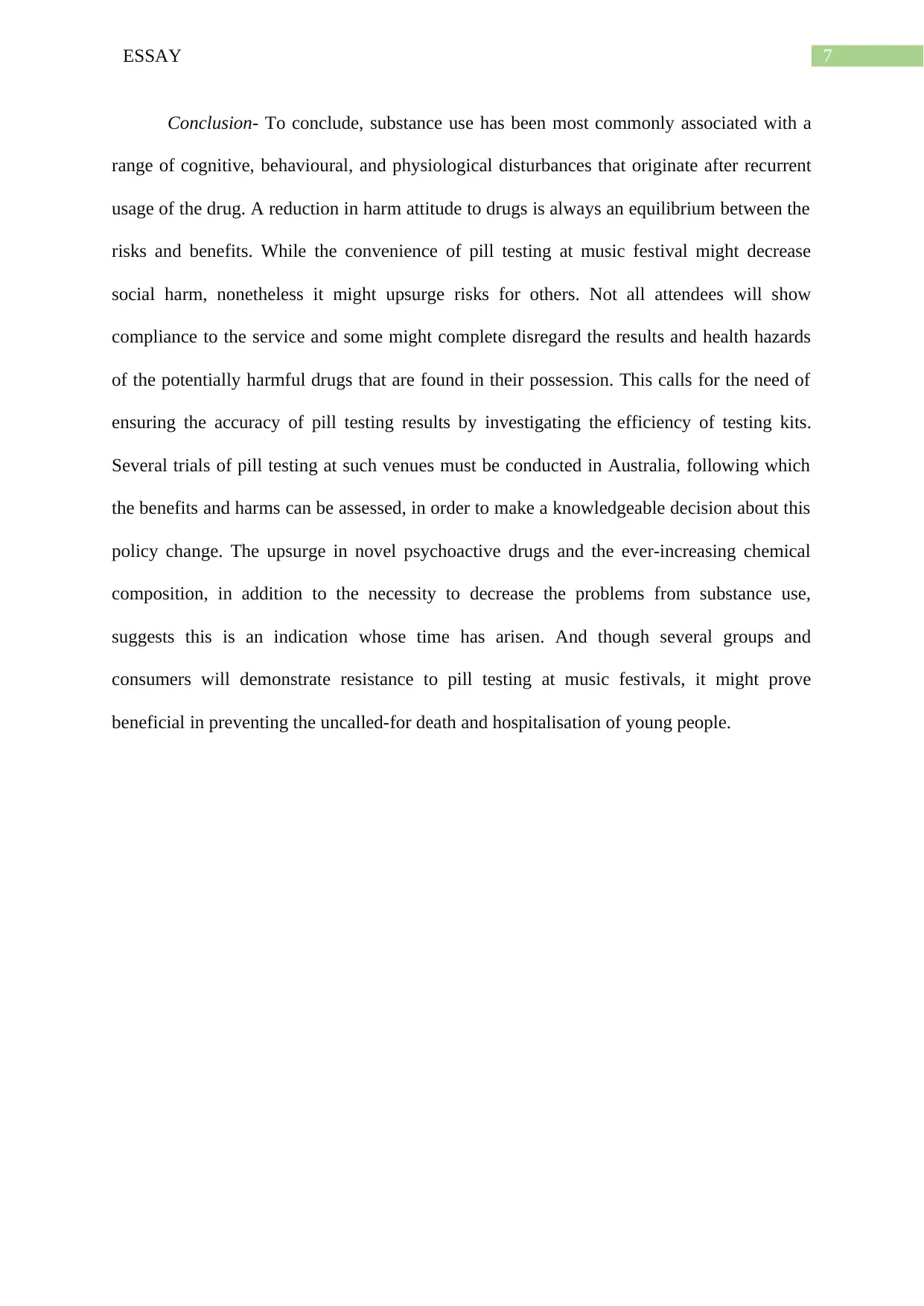
7ESSAY
Conclusion- To conclude, substance use has been most commonly associated with a
range of cognitive, behavioural, and physiological disturbances that originate after recurrent
usage of the drug. A reduction in harm attitude to drugs is always an equilibrium between the
risks and benefits. While the convenience of pill testing at music festival might decrease
social harm, nonetheless it might upsurge risks for others. Not all attendees will show
compliance to the service and some might complete disregard the results and health hazards
of the potentially harmful drugs that are found in their possession. This calls for the need of
ensuring the accuracy of pill testing results by investigating the efficiency of testing kits.
Several trials of pill testing at such venues must be conducted in Australia, following which
the benefits and harms can be assessed, in order to make a knowledgeable decision about this
policy change. The upsurge in novel psychoactive drugs and the ever-increasing chemical
composition, in addition to the necessity to decrease the problems from substance use,
suggests this is an indication whose time has arisen. And though several groups and
consumers will demonstrate resistance to pill testing at music festivals, it might prove
beneficial in preventing the uncalled-for death and hospitalisation of young people.
Conclusion- To conclude, substance use has been most commonly associated with a
range of cognitive, behavioural, and physiological disturbances that originate after recurrent
usage of the drug. A reduction in harm attitude to drugs is always an equilibrium between the
risks and benefits. While the convenience of pill testing at music festival might decrease
social harm, nonetheless it might upsurge risks for others. Not all attendees will show
compliance to the service and some might complete disregard the results and health hazards
of the potentially harmful drugs that are found in their possession. This calls for the need of
ensuring the accuracy of pill testing results by investigating the efficiency of testing kits.
Several trials of pill testing at such venues must be conducted in Australia, following which
the benefits and harms can be assessed, in order to make a knowledgeable decision about this
policy change. The upsurge in novel psychoactive drugs and the ever-increasing chemical
composition, in addition to the necessity to decrease the problems from substance use,
suggests this is an indication whose time has arisen. And though several groups and
consumers will demonstrate resistance to pill testing at music festivals, it might prove
beneficial in preventing the uncalled-for death and hospitalisation of young people.
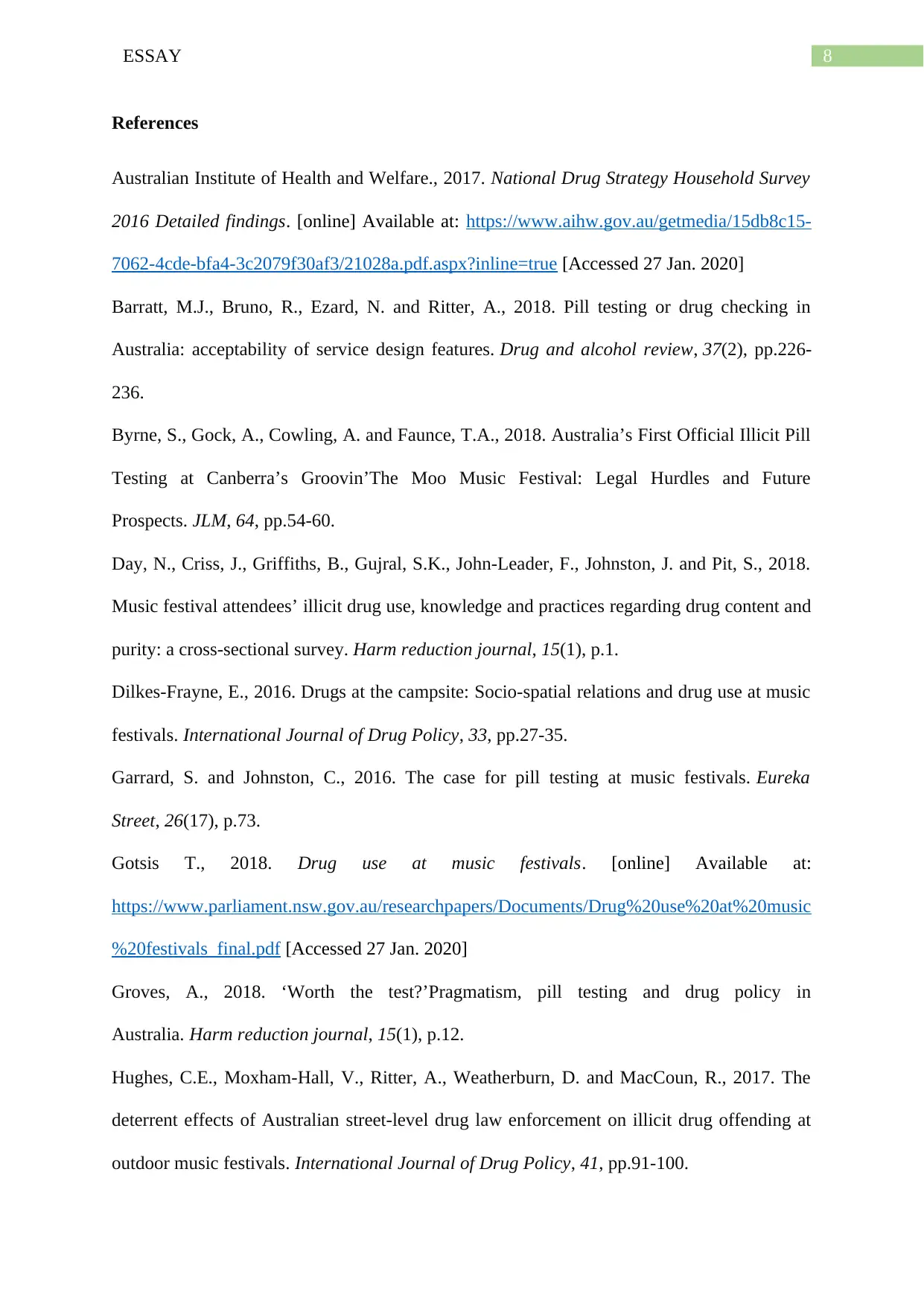
8ESSAY
References
Australian Institute of Health and Welfare., 2017. National Drug Strategy Household Survey
2016 Detailed findings. [online] Available at: https://www.aihw.gov.au/getmedia/15db8c15-
7062-4cde-bfa4-3c2079f30af3/21028a.pdf.aspx?inline=true [Accessed 27 Jan. 2020]
Barratt, M.J., Bruno, R., Ezard, N. and Ritter, A., 2018. Pill testing or drug checking in
Australia: acceptability of service design features. Drug and alcohol review, 37(2), pp.226-
236.
Byrne, S., Gock, A., Cowling, A. and Faunce, T.A., 2018. Australia’s First Official Illicit Pill
Testing at Canberra’s Groovin’The Moo Music Festival: Legal Hurdles and Future
Prospects. JLM, 64, pp.54-60.
Day, N., Criss, J., Griffiths, B., Gujral, S.K., John-Leader, F., Johnston, J. and Pit, S., 2018.
Music festival attendees’ illicit drug use, knowledge and practices regarding drug content and
purity: a cross-sectional survey. Harm reduction journal, 15(1), p.1.
Dilkes-Frayne, E., 2016. Drugs at the campsite: Socio-spatial relations and drug use at music
festivals. International Journal of Drug Policy, 33, pp.27-35.
Garrard, S. and Johnston, C., 2016. The case for pill testing at music festivals. Eureka
Street, 26(17), p.73.
Gotsis T., 2018. Drug use at music festivals. [online] Available at:
https://www.parliament.nsw.gov.au/researchpapers/Documents/Drug%20use%20at%20music
%20festivals_final.pdf [Accessed 27 Jan. 2020]
Groves, A., 2018. ‘Worth the test?’Pragmatism, pill testing and drug policy in
Australia. Harm reduction journal, 15(1), p.12.
Hughes, C.E., Moxham-Hall, V., Ritter, A., Weatherburn, D. and MacCoun, R., 2017. The
deterrent effects of Australian street-level drug law enforcement on illicit drug offending at
outdoor music festivals. International Journal of Drug Policy, 41, pp.91-100.
References
Australian Institute of Health and Welfare., 2017. National Drug Strategy Household Survey
2016 Detailed findings. [online] Available at: https://www.aihw.gov.au/getmedia/15db8c15-
7062-4cde-bfa4-3c2079f30af3/21028a.pdf.aspx?inline=true [Accessed 27 Jan. 2020]
Barratt, M.J., Bruno, R., Ezard, N. and Ritter, A., 2018. Pill testing or drug checking in
Australia: acceptability of service design features. Drug and alcohol review, 37(2), pp.226-
236.
Byrne, S., Gock, A., Cowling, A. and Faunce, T.A., 2018. Australia’s First Official Illicit Pill
Testing at Canberra’s Groovin’The Moo Music Festival: Legal Hurdles and Future
Prospects. JLM, 64, pp.54-60.
Day, N., Criss, J., Griffiths, B., Gujral, S.K., John-Leader, F., Johnston, J. and Pit, S., 2018.
Music festival attendees’ illicit drug use, knowledge and practices regarding drug content and
purity: a cross-sectional survey. Harm reduction journal, 15(1), p.1.
Dilkes-Frayne, E., 2016. Drugs at the campsite: Socio-spatial relations and drug use at music
festivals. International Journal of Drug Policy, 33, pp.27-35.
Garrard, S. and Johnston, C., 2016. The case for pill testing at music festivals. Eureka
Street, 26(17), p.73.
Gotsis T., 2018. Drug use at music festivals. [online] Available at:
https://www.parliament.nsw.gov.au/researchpapers/Documents/Drug%20use%20at%20music
%20festivals_final.pdf [Accessed 27 Jan. 2020]
Groves, A., 2018. ‘Worth the test?’Pragmatism, pill testing and drug policy in
Australia. Harm reduction journal, 15(1), p.12.
Hughes, C.E., Moxham-Hall, V., Ritter, A., Weatherburn, D. and MacCoun, R., 2017. The
deterrent effects of Australian street-level drug law enforcement on illicit drug offending at
outdoor music festivals. International Journal of Drug Policy, 41, pp.91-100.
⊘ This is a preview!⊘
Do you want full access?
Subscribe today to unlock all pages.

Trusted by 1+ million students worldwide
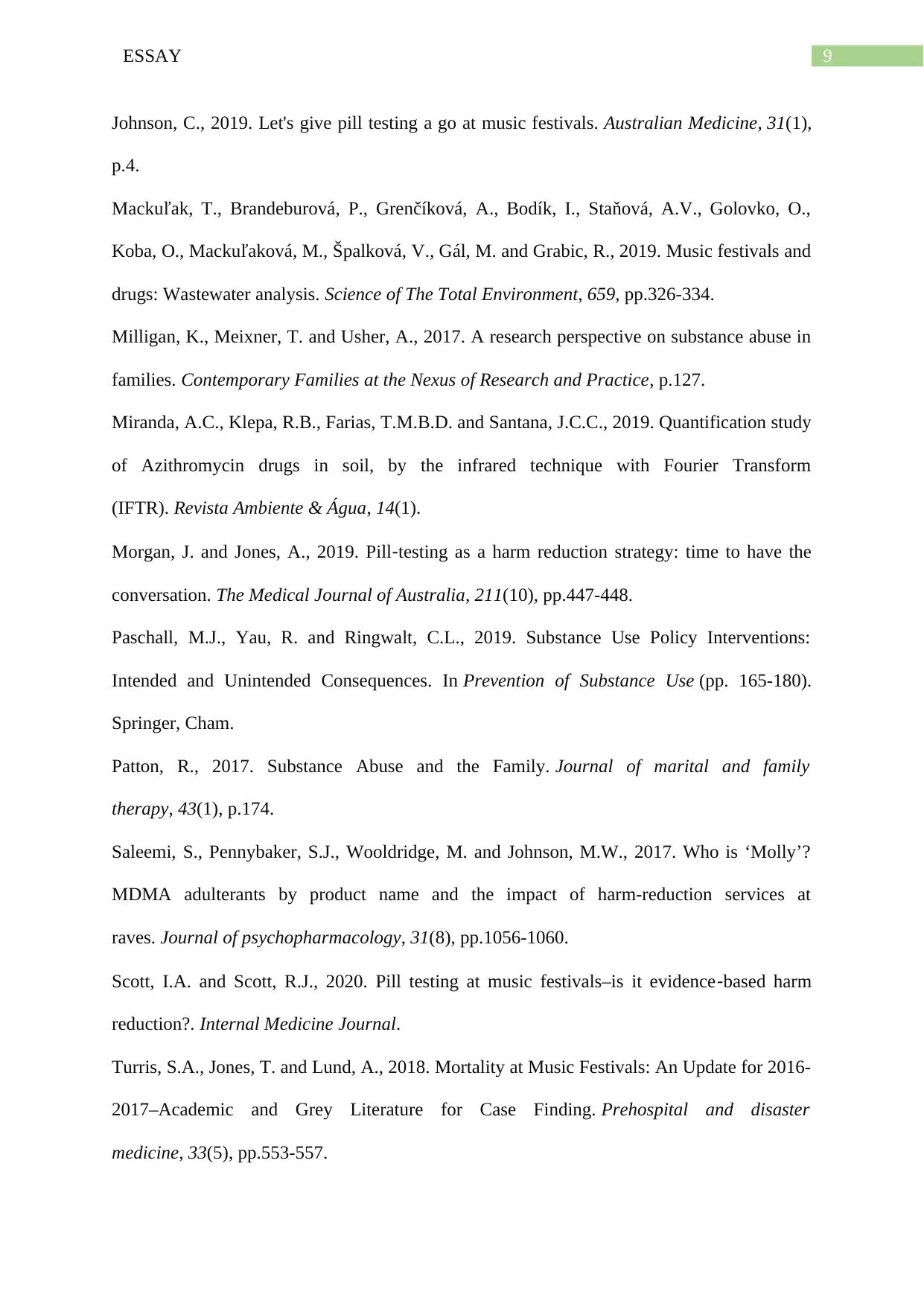
9ESSAY
Johnson, C., 2019. Let's give pill testing a go at music festivals. Australian Medicine, 31(1),
p.4.
Mackuľak, T., Brandeburová, P., Grenčíková, A., Bodík, I., Staňová, A.V., Golovko, O.,
Koba, O., Mackuľaková, M., Špalková, V., Gál, M. and Grabic, R., 2019. Music festivals and
drugs: Wastewater analysis. Science of The Total Environment, 659, pp.326-334.
Milligan, K., Meixner, T. and Usher, A., 2017. A research perspective on substance abuse in
families. Contemporary Families at the Nexus of Research and Practice, p.127.
Miranda, A.C., Klepa, R.B., Farias, T.M.B.D. and Santana, J.C.C., 2019. Quantification study
of Azithromycin drugs in soil, by the infrared technique with Fourier Transform
(IFTR). Revista Ambiente & Água, 14(1).
Morgan, J. and Jones, A., 2019. Pill‐testing as a harm reduction strategy: time to have the
conversation. The Medical Journal of Australia, 211(10), pp.447-448.
Paschall, M.J., Yau, R. and Ringwalt, C.L., 2019. Substance Use Policy Interventions:
Intended and Unintended Consequences. In Prevention of Substance Use (pp. 165-180).
Springer, Cham.
Patton, R., 2017. Substance Abuse and the Family. Journal of marital and family
therapy, 43(1), p.174.
Saleemi, S., Pennybaker, S.J., Wooldridge, M. and Johnson, M.W., 2017. Who is ‘Molly’?
MDMA adulterants by product name and the impact of harm-reduction services at
raves. Journal of psychopharmacology, 31(8), pp.1056-1060.
Scott, I.A. and Scott, R.J., 2020. Pill testing at music festivals–is it evidence‐based harm
reduction?. Internal Medicine Journal.
Turris, S.A., Jones, T. and Lund, A., 2018. Mortality at Music Festivals: An Update for 2016-
2017–Academic and Grey Literature for Case Finding. Prehospital and disaster
medicine, 33(5), pp.553-557.
Johnson, C., 2019. Let's give pill testing a go at music festivals. Australian Medicine, 31(1),
p.4.
Mackuľak, T., Brandeburová, P., Grenčíková, A., Bodík, I., Staňová, A.V., Golovko, O.,
Koba, O., Mackuľaková, M., Špalková, V., Gál, M. and Grabic, R., 2019. Music festivals and
drugs: Wastewater analysis. Science of The Total Environment, 659, pp.326-334.
Milligan, K., Meixner, T. and Usher, A., 2017. A research perspective on substance abuse in
families. Contemporary Families at the Nexus of Research and Practice, p.127.
Miranda, A.C., Klepa, R.B., Farias, T.M.B.D. and Santana, J.C.C., 2019. Quantification study
of Azithromycin drugs in soil, by the infrared technique with Fourier Transform
(IFTR). Revista Ambiente & Água, 14(1).
Morgan, J. and Jones, A., 2019. Pill‐testing as a harm reduction strategy: time to have the
conversation. The Medical Journal of Australia, 211(10), pp.447-448.
Paschall, M.J., Yau, R. and Ringwalt, C.L., 2019. Substance Use Policy Interventions:
Intended and Unintended Consequences. In Prevention of Substance Use (pp. 165-180).
Springer, Cham.
Patton, R., 2017. Substance Abuse and the Family. Journal of marital and family
therapy, 43(1), p.174.
Saleemi, S., Pennybaker, S.J., Wooldridge, M. and Johnson, M.W., 2017. Who is ‘Molly’?
MDMA adulterants by product name and the impact of harm-reduction services at
raves. Journal of psychopharmacology, 31(8), pp.1056-1060.
Scott, I.A. and Scott, R.J., 2020. Pill testing at music festivals–is it evidence‐based harm
reduction?. Internal Medicine Journal.
Turris, S.A., Jones, T. and Lund, A., 2018. Mortality at Music Festivals: An Update for 2016-
2017–Academic and Grey Literature for Case Finding. Prehospital and disaster
medicine, 33(5), pp.553-557.
Paraphrase This Document
Need a fresh take? Get an instant paraphrase of this document with our AI Paraphraser
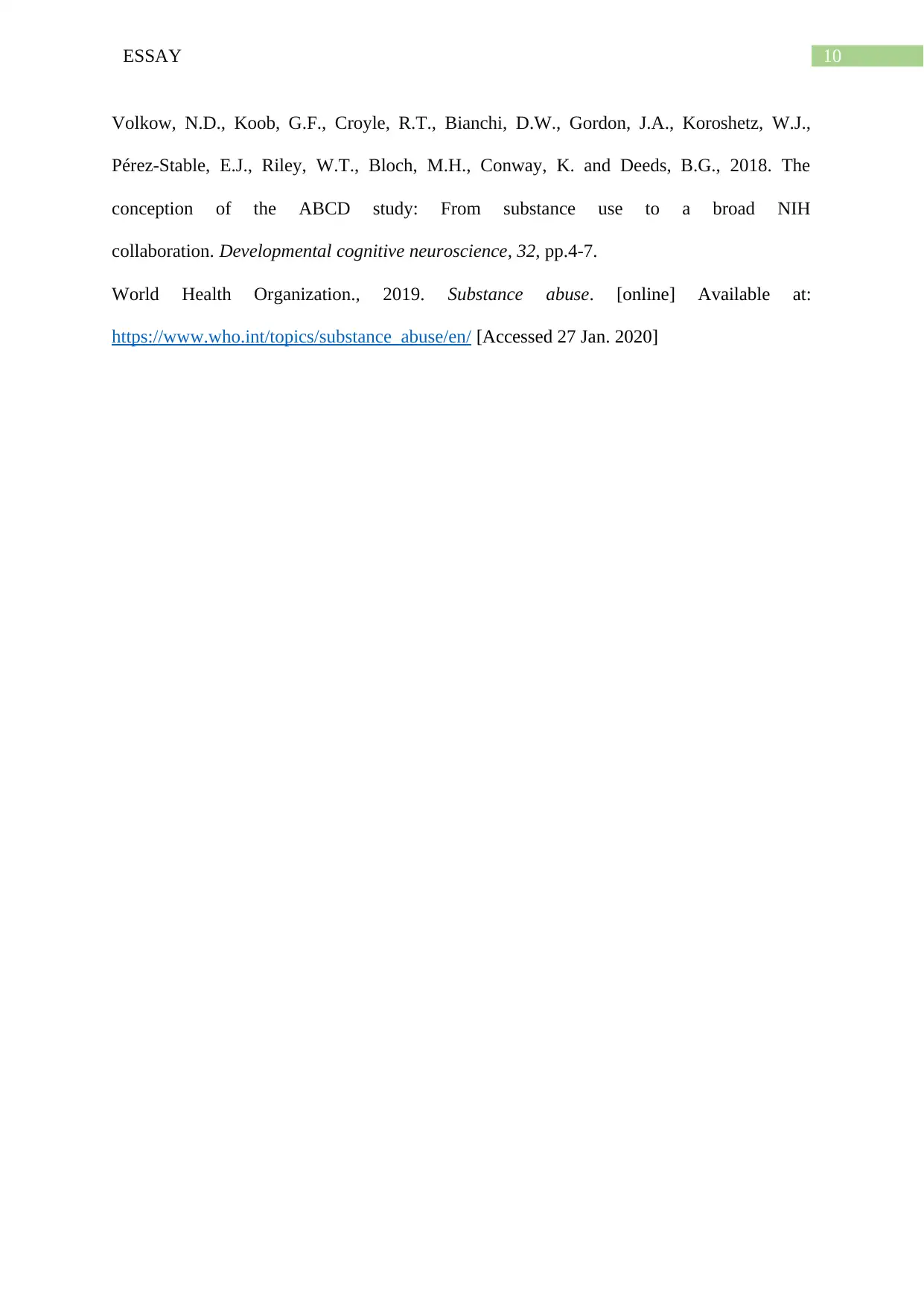
10ESSAY
Volkow, N.D., Koob, G.F., Croyle, R.T., Bianchi, D.W., Gordon, J.A., Koroshetz, W.J.,
Pérez-Stable, E.J., Riley, W.T., Bloch, M.H., Conway, K. and Deeds, B.G., 2018. The
conception of the ABCD study: From substance use to a broad NIH
collaboration. Developmental cognitive neuroscience, 32, pp.4-7.
World Health Organization., 2019. Substance abuse. [online] Available at:
https://www.who.int/topics/substance_abuse/en/ [Accessed 27 Jan. 2020]
Volkow, N.D., Koob, G.F., Croyle, R.T., Bianchi, D.W., Gordon, J.A., Koroshetz, W.J.,
Pérez-Stable, E.J., Riley, W.T., Bloch, M.H., Conway, K. and Deeds, B.G., 2018. The
conception of the ABCD study: From substance use to a broad NIH
collaboration. Developmental cognitive neuroscience, 32, pp.4-7.
World Health Organization., 2019. Substance abuse. [online] Available at:
https://www.who.int/topics/substance_abuse/en/ [Accessed 27 Jan. 2020]
1 out of 11
Related Documents
Your All-in-One AI-Powered Toolkit for Academic Success.
+13062052269
info@desklib.com
Available 24*7 on WhatsApp / Email
![[object Object]](/_next/static/media/star-bottom.7253800d.svg)
Unlock your academic potential
Copyright © 2020–2025 A2Z Services. All Rights Reserved. Developed and managed by ZUCOL.





